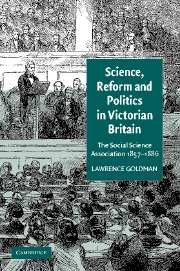Book contents
- Frontmatter
- Contents
- List of illustrations
- Acknowledgements
- Note on citations in the text
- List of abbreviations
- Introduction: the contexts of the Social Science Association
- Part I POLITICS
- Chapter 1 The origins of the Social Science Association: legal reform, the reformation of juveniles, and the property of married women in ‘the Age of Equipoise’
- Chapter 2 The Social Science Association and the structure of mid-Victorian politics
- Chapter 3 Organising the Social Science Association
- Part II REFORM
- Part III SCIENCE
- Part IV DECLINE
- Conclusion: The Social Science Association and social knowledge
- Appendix I The founders of the Social Science Association, 29 July 1857
- Appendix II Social Science Association Congresses, 1857–1884
- Appendix III Presidents of the Social Science Congresses, 1857–1884
- Appendix IV Departmental presidents, 1857–1884
- Select bibliography
- Index
Chapter 2 - The Social Science Association and the structure of mid-Victorian politics
Published online by Cambridge University Press: 22 September 2009
- Frontmatter
- Contents
- List of illustrations
- Acknowledgements
- Note on citations in the text
- List of abbreviations
- Introduction: the contexts of the Social Science Association
- Part I POLITICS
- Chapter 1 The origins of the Social Science Association: legal reform, the reformation of juveniles, and the property of married women in ‘the Age of Equipoise’
- Chapter 2 The Social Science Association and the structure of mid-Victorian politics
- Chapter 3 Organising the Social Science Association
- Part II REFORM
- Part III SCIENCE
- Part IV DECLINE
- Conclusion: The Social Science Association and social knowledge
- Appendix I The founders of the Social Science Association, 29 July 1857
- Appendix II Social Science Association Congresses, 1857–1884
- Appendix III Presidents of the Social Science Congresses, 1857–1884
- Appendix IV Departmental presidents, 1857–1884
- Select bibliography
- Index
Summary
The Social Science Association was focused on parliament, sought ways of influencing legislation, and applied pressure to ministers. It was founded because the political system was neglecting social issues in the 1850s, and it contributed to the process by which the content of politics and the competence of the state were gradually expanded to include and deal with social questions. The Association has a place, therefore, in the history of parties and politics from the 1850s to the 1880s – specifically, as an element in the process by which politics were popularised in the mid-Victorian period and became more responsive to extra-parliamentary organisations and opinion. At an SSA congress the podium was used by politicians to reach new audiences who, for their part, were eager to be drawn into a political system now responsive to their interests and votes. If Gladstone made legislative reform ‘the main function of government’ after 1868 it owed something to pressure from bodies like the Social Science Association.
It is intrinsic to John Vincent's classic analysis of Liberal politics in this period that the parties had neither a policy-making function nor competence: these devolved by default on enthusiastic members of a cabinet, often acting with the support of pressure groups or external expertise. The very limitations of this ad hoc system of policy formation gave rise to the SSA: at a congress, ministers, bureaucrats, and the local middle-class elites that constituted Victorian ‘public opinion’ were brought together.
- Type
- Chapter
- Information
- Science, Reform, and Politics in Victorian BritainThe Social Science Association 1857–1886, pp. 61 - 84Publisher: Cambridge University PressPrint publication year: 2002



